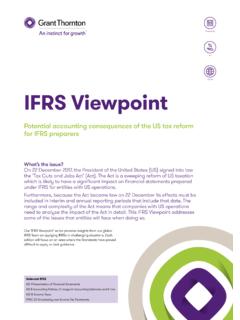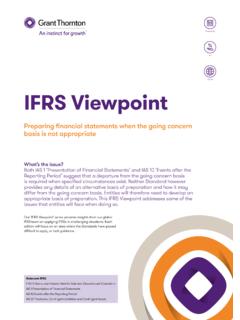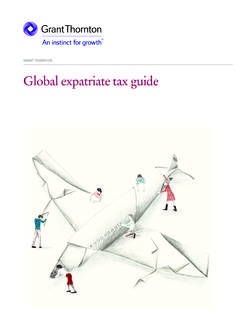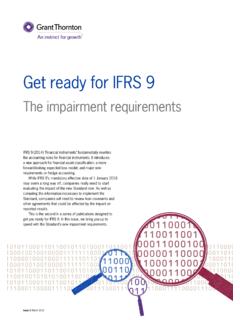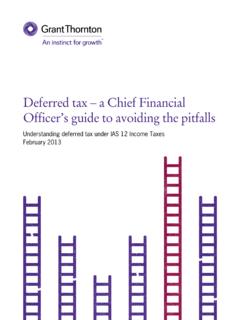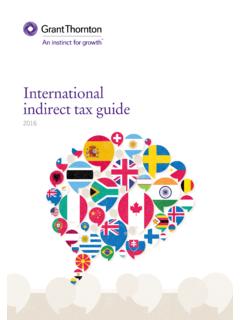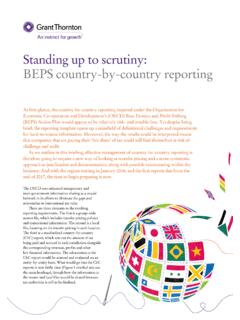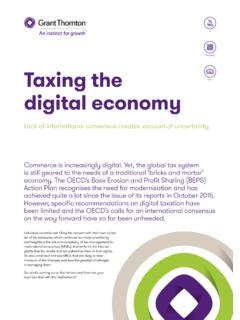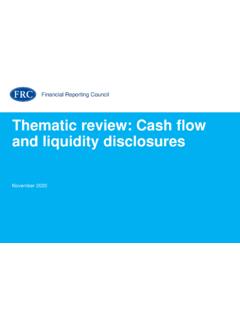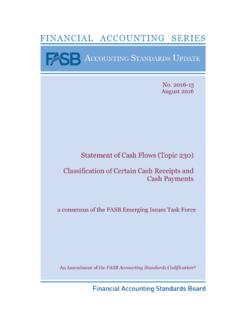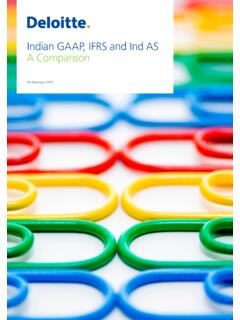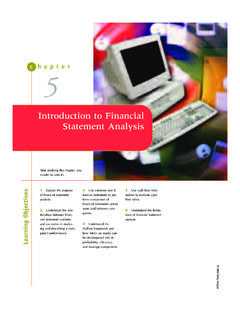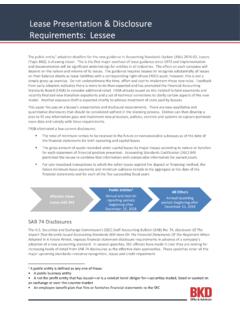Transcription of IAS 7: Statement of Cash Flows - Grant Thornton International
1 ias 7 : Statement of Cash FlowsA guide to avoiding common pitfalls and application issuesAugust 2012 Important Disclaimer:This document has been developed as an information resource. It is intended as a guide only and the application of its contents to specific situations will depend on the particular circumstances involved. While every care has been taken in its presentation, personnel who use this document to assist in evaluating compliance with International Financial Reporting Standards should have sufficient training and experience to do so. No person should act specifically on the basis of the material contained herein without considering and taking professional advice.
2 Neither Grant Thornton International Ltd, nor any of its personnel nor any of its member firms or their partners or employees, accept any responsibility for any errors it might contain, whether caused by negligence or otherwise, or any loss, howsoever caused, incurred by any person as a result of utilising or otherwise placing any reliance upon this 7: Statement of Cash Flows iStatement of Cash FlowsThe phrase cash is king is not new but became even more relevant during the global financial crisis. For some the Statement of Cash Flows is the most important information in the financial statements, as it: provides unbiased, objective information that is relatively free from estimation uncertainty allows financial Statement users to assess an entity s past forecasts and use that information as the basis for future decision-making and future performance allows financial Statement users to compare performance of various entities across industries or geographic locations.
3 Cash flow reporting is addressed in International Financial Reporting Standards (IFRS) by International Accounting Standards (IAS) 7 Statement of Cash Flows ( ias 7 , the Standard). A Statement of Cash Flows is part of an entity s complete set of financial statements in accordance with paragraph 10 of IAS 1 Presentation of Financial Statements (IAS ). Further, ias 7 requires all entities to present a Statement of Cash Flows with no exceptions (IAS ). The increasing attention on companies cash generation and liquidity position has led to greater focus on the Statement of Cash Flows by financial Statement users, regulators and other commentators.
4 However, this additional focus and scrutiny has also highlighted some common errors and inconsistencies in the application of ias 7 . Fortunately, the member firms within Grant Thornton International Ltd ( Grant Thornton International ) one of the world s leading organisations of independently owned and managed accounting and consulting firms have gained extensive insights into the Statement of Cash Flows . Grant Thornton International , through its IFRS team, develops general guidance that supports its member firms commitment to high quality, consistent application of IFRS.
5 We are pleased to share these insights by publishing ias 7 : Statement of Cash guide to avoiding common pitfalls and application issues (the Guide) to assist users in addressing difficult interpretative issues arising from the application of ias 7 . Using the GuideThe objectives of the Guide are to: remind management of the basic requirements of ias 7 highlight interpretative and practical application issues provide management with insights to address these issues. To meet these objectives, the Guide is organised as follows:Introduction2 ias 7 : Statement of Cash FlowsOverview of the GuideGrant Thornton International LtdAugust 2012 Section A: ias 7 at a glance Provides an at a glance overview of ias 7 s main requirements Section B.
6 Identifying cash and cash equivalents Defines cash and cash equivalents and discusses application issues related to various instruments (eg bank overdrafts, demand deposits, money market funds, restricted cash) Outlines the requirements for reconciling cash and cash equivalents in the Statement of Cash Flows to the cash and cash equivalents balance in the Statement of Financial Position and common application issues in doing soSection C:Classifying cash Flows as operating, investing or financing activities Outlines the requirements for classifying cash Flows as operating, investing or financing activities Provides common examples of cash Flows from operating, investing and financing activities Addresses various application issues that arise when classifying cash Flows as operating, investing or financing activitiesSection D: Presentation issues Summarises the general presentation requirements of ias 7 Discusses common presentation application issues including.
7 Gross versus net presentation using the indirect method impact of a central banking function disclosure of total interest paid cash flow per shareSection E: Group cash Flows Provides an overview of the cash flow requirements related to: business combinations accounting for groups Addresses common application issues related to bothSection F: Foreign currency cash Flows Provides an overview of the requirements related to cash Flows from foreign currency transactions Addresses common application issues on this topicIntroduction iA. ias 7 at a glance 1B.
8 Identifying cash and cash equivalents 31 Guidance overview 3 Defining cash and cash equivalents 32 Application issues 4 Exploring the meaning of short-term 4 Bank overdrafts 4 Demand deposits 4 Money market funds 5 Restricted cash 6 Reconciling cash and cash equivalent balances 8C. Classifying cash Flows as operating, investing or financing activities 91 Guidance overview 9 Classifying cash Flows as operating.
9 Investing or financing activities 92 Application issues 10 Interest and dividends 11 Short-term loans to related parties 12 Expenditure on internally generated intangibles 13 Cash Flows relating to assets held for rental to others 13 Cash Flows relating to a business combination 13 Tax cash Flows 13D. Presentation issues 141 Guidance overview 14 Gross cash Flows 14 Selecting the direct or indirect methods 15 Direct method 15 Indirect method 15 Non-cash transactions 16 Contents2 Application issues 16 Gross or net cash Flows ?
10 16 Starting point for the indirect method 17 Presentation of adjustments to profit or loss using the indirect method 17 Non-cash transactions 17 Central banking function 18 Disclosure of total interest paid 19 Cash flow per share 19E. Group cash Flows 201 Guidance overview 202 Application issues 21 Cash Flows relating to business combinations 21 Deferred consideration 21 Contingent consideration 22 Cash and cash equivalents acquired 22 Transaction costs 23 Other group cash flow considerations 24 Changes in non-controlling interests 24 Acquisitions and disposals of subsidiaries 24F.

